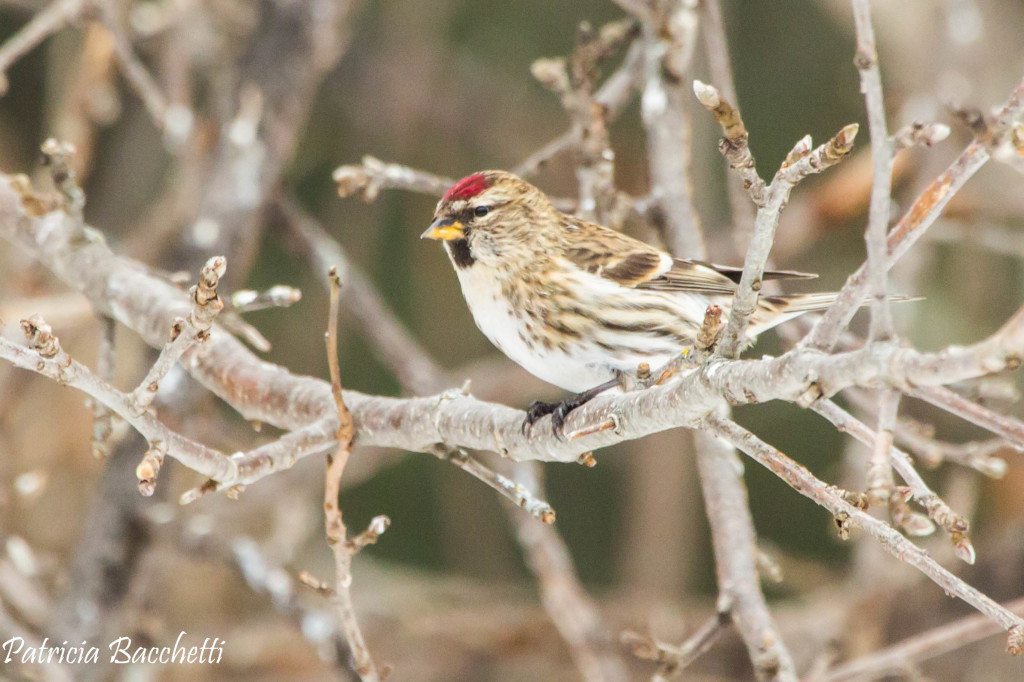A California birder in chilly Minnesota
By Pat Bacchetti
When I told friends that I was going to Minnesota in January, the most common response was “Why on earth would you go there then?!”
I started to have second thoughts as well, as I watched temperatures in Duluth dip below zero, with the wind chill reading hovering around -20F. But as a life-long Californian, I was looking forward to experiencing a Northland winter as well as the birds that favor that climate. So off I went to Minneapolis on December 31, with three Dungeness Crabs in tow for a New Year’s party, and many layers of down clothing.
Our first stop was for Snowy Owls, who like the long flat fields around airports to hunt for their mousy prey during the day. As my friend in Minneapolis, Susan, drove us around the cargo area of Minneapolis International, we dodged airport security looking for owls. We were able to finally locate my life-list Snowy Owl, a beautiful pure white male, sitting on a building near the runway. It was a thrill to finally see one of these beautiful Arctic owls. We would see two more at the Richard I Bong Airport in Superior, Wisconsin, but the first sighting is always the most memorable.

Duluth was the next stop, for a Minnesota Birding Weekends fieldtrip. Duluth is a delightful old port town at the southwest tip of Lake Superior that’s been transformed into a tourist destination, with galleries, cafes, and excellent restaurants. Though ore boats still ply the lake, visitors are more important for its economy these days. Lake Superior held Minnesota’s third state record Common Eider, who has been living near the pier since November. In addition to the eider, a couple of Northern Pintails and American Black Ducks were hanging out with the mallard/goldeneye flock, unexpected visitors in January.
For a Californian, the next target bird was a lesson in perspective: a Golden-crowned Sparrow had been at a feeder for the month of December, and this was a much-desired state sighting for Minnesota birders. After a brief appearance by the sparrow, we headed off to find Hoary Redpolls in the large flocks of Common Redpolls that winter in the area. Kim Eckert, our leader, found a single Hoary Redpoll in a large flock of Common Redpolls. We were able to compare the silvery unstreaked chest color of the Hoary with its more numerous Common cousins, and I was able to log another life bird.

On our way to the redpolls, two Northern Hawk Owls were in adjacent meadows. These beautiful day-time hunters breed in the far north, and we were able to observe them closely as they hunted from the tops of conifers. A Ruffed Grouse posed for us in a meadow as the rest of its family crossed the road, one of the three grouse species that are resident.
Sax-Zim Bog is 50 minutes northwest of Duluth, and is a well-known wintering area for Great Gray Owl, Northern Hawk Owl, Northern Rough-winged Hawk, Northern Shrike, Boreal Chickadee, White-winged Crossbills, Bohemian Waxwings, as well as Black-backed and Three-toed Woodpeckers. The bog is a 200-square-mile area of hardwood and softwood wetlands, which in the summer serves as a breeding ground for over 150 species of birds. The local rural community of Meadowland sponsors a birding festival in February, and the mixture of state and private land is stewarded by the Friends of Sax-Zim Bog.


Every birder’s wish is to see Great Gray Owls in the bog, but we were faced with severe weather constraints. Not only were the temperatures dipping below zero, but the wind was blowing just hard enough to make hunting difficult for the sound-guided owls. Even winds of 10 mph can disrupt the owls’ ability to hear their prey, so they tend to hang out in the trees and not fly.
We spent four long cold hours over two days driving the known Great Gray areas with the windows down and chemical hand warmers in our gloves. Sadly, they were not to be seen on our watch (though two were found the next morning when the winds died down). We were rewarded with Boreal Chickadees at the Admiral Road feeders, a Northern Shrike, and a porcupine feeding on buds high in an alder tree. Crossbills and waxwings were scarce, since they are wintering where food sources are more abundant.
In total, we saw 40 species over the weekend of birding. The temperatures hovered between zero and -20 degrees, and though my winter gear kept me warm, I was impressed with how birds and people can adapt to the extreme weather. Being able to see so many Arctic specialties in the Lower 48 was a treat, so the next time someone suggests birding Minnesota in the winter, say “You betcha!”
——————–
Pat Bacchetti discovered birding nine years ago in Costa Rica, came home to Oakland and took every Golden Gate Bird Alliance birding class she could, and since then has merrily chased birds through 48 California counties, ten states, and eight countries. When not birding, she’s practicing veterinary medicine. Her ultimate goal is to see a coot in all 58 California counties.

